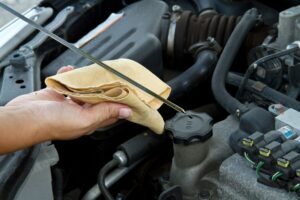
Burning oil can reduce engine efficiency and increase your vehicle’s emissions. Left unresolved, it can cause long-term mechanical damage to your car. In this guide, we’ll explain its leading causes and answer important questions like:
- How do I spot the signs of burning engine oil?
- What can car owners do to fix it?
- Why is my car burning oil fast with no leak?
- What products can I use to protect the engine and improve performance?
What It Means When Your Car Is Burning Oil
Issues with your oil levels can point to serious engine issues rather than external leaks. Burning oil means your car’s engine oil has entered the combustion chamber, where it’s burned along with fuel and air. This process isn’t normal and often signals wear or malfunction in critical engine components.
Some common symptoms include a noticeable drop in oil levels between changes or reduced fuel efficiency. Some vehicles may burn oil gradually, while others lose it rapidly. You can notice these symptoms, especially when the car is always under high load or at higher mileage.
Oil burning can occur even without visible leaks. If you’re wondering why your car is burning so much oil, a proper diagnosis can help you determine the issue and prevent costly repairs.
Common Reasons Why Your Car Is Burning Oil
You’re likely dealing with internal engine problems, which might need fuel additives and treatments. However, to determine which products to use, it helps to know what some of the most common causes of oil burning are:
-
Worn Valve Seals or Piston Rings
These are the most common causes of oil burning. While they prevent oil from entering the combustion chamber, they can degrade over time. Eventually, oil can slip past and burn along with the air-fuel mixture. If you haven’t had your car serviced for a while or have an older, high-mileage engine, this could be the source of your issue, especially if you’ve noticed increased oil consumption.
-
Faulty Positive Crankcase Ventilation (PCV) Valve
The PCV valve helps regulate the pressure inside your car’s engine by redirecting gases back into the intake system. If the PCV valve becomes clogged, it can let oil vapor enter the intake manifold, resulting in gradual oil loss even with no visible leaks. A faulty PCV system may also cause rough idling or misfires.
-
Carbon Buildup and Engine Deposits
Heavy carbon buildup in the combustion chamber can cause hot spots that lead to oil burning. These deposits often form over time due to low-quality fuel or infrequent maintenance. The buildup also prevents valves and rings from sealing properly, allowing oil to seep through.
A high-quality cleaner like Berryman® B-12 Chemtool® Total Fuel System Clean-Up can help remove these deposits and restore engine efficiency.
-
Turbocharged Engine Stress and Driving Habits
Turbocharged engines naturally run hotter and under more pressure than non-turbo engines. This added stress increases oil breakdown and volatility, leading to oil entering the combustion chamber. Aggressive driving habits and infrequent oil changes can worsen the problem.
- Leaky Gaskets or Internal Seepage
While most gasket failures lead to external oil leaks, a damaged head gasket or intake manifold gasket can allow oil to leak internally into the combustion chamber. This seepage often goes unnoticed because it doesn’t leave oil stains on the ground. Symptoms may include overheating, coolant contamination, or white and blue exhaust smoke.
How To Diagnose the Problem
The following steps can help identify whether a vehicle is leaking or the engine is burning oil. Once you’ve spotted common warning signs and other indicators, you can take the next steps to address the source of your engine’s issues.
Step 1: Check for Blue Exhaust Smoke
Blue smoke, especially on startup or acceleration, often means oil is entering the combustion chamber.
Step 2: Monitor Oil Levels
Check your dipstick weekly. A fast drop in oil levels without puddles underneath suggests internal burning.
Step 3: Inspect the PCV Valve
Remove and inspect the PCV valve. A stuck or clogged valve can cause oil to be drawn into the intake manifold.
Step 4: Examine Spark Plugs
Remove a few spark plugs. Oil-fouled tips or carbon buildup may indicate oil getting past valve seals or rings.
Step 5: Run a Compression or Leak-Down Test
This confirms if your piston rings or valves are worn, which is especially useful for high-mileage engines.
Specialists from Berryman Products have helped clients resolve this issue by recommending tailored solutions. For instance, one customer reached out because their 2009 Toyota RAV4 started burning oil quickly. We recommended our cleaning products to address potential issues.
How To Fix or Minimize Oil Burning
The solution to this engine problem will depend on the underlying cause. Repairs may be necessary if mechanical parts like valve seals or piston rings are worn out. However, regular maintenance often reduces the issue for mild to moderate oil burning.
You can start by flushing your engine oil to remove sludge and deposits that may interfere with seals. Learn the best way to flush engine oil.
Next, treat your fuel system with Berryman® B-12 Chemtool® or Berryman® B-60 High Mileage Fuel System Rejuvenator to clean carbon buildup in the combustion chamber. Routine use of high-quality cleaners can help reduce oil consumption and extend engine life.
Important Tip: If increased oil consumption continues despite maintenance, or if you still see blue smoke constantly, it’s time to consult a professional mechanic for a deeper inspection and potential repairs.
Protect Your Engine From Costly Damage
Your car’s engine may be affected by worn engine parts that require mechanical repair. However, many cases of oil burning can be addressed with timely cleaning and high-quality products. Find Berryman Products near you, or become a distributor to offer trusted solutions in your shop or region.
